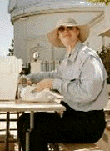|
|
This topic comprises 2 pages: 1 2
|
|
Author
|
Topic: economics of 70mm releases (historical question)
|
|
|
|
|
Steve Guttag
We forgot the crackers Gromit!!!

Posts: 12814
From: Annapolis, MD
Registered: Dec 1999
|
 posted 12-15-2015 06:27 AM
posted 12-15-2015 06:27 AM




I think the real answer is you have competing forces at play.
Earlier in the era, there would have been fewer screens capable and most would have been LARGE houses. As always, there is a ranking system to the various markets. That is NY and LA are at the top of the ranking and will always have more opportunity on such things than other markets...the next tier was Chicago and Washington, DC. As such, the market it "grew up in" often had 70mm showing somewhere in the Summer/Winter months, but particularly the summer months.
70mm brought three things to the table for the studio and exhibitor...legitimacy to the title and with that exclusivity (typically, the 70mm houses had a 2-4 week exclusive engagement as well as a larger radius of non-competition) and finally, 70mm offered the best way to get the mix the dub stage heard to the theatre. Before SVA became commonplace, 90% of what theatres showed was MONO. So on an effects laden movie like Star Wars or Raiders of the Lost Ark, 70mm is going to get you the discrete tracks with the widest frequency response into the biggest, most prestigious houses. Yes, there was 4-track magnetic that could deliver much of that but lacking the bass enhancement and with comparatively thinner tracks running 25% slower in an overall less stable system than 70mm.
Mind you, prestige was not the primary driving force...movies like Reds or Sophie's Choice didn't play in 70mm though they were the serious films of their winter season (if there were 70mm prints made, I'm sure the likes of Michael Coate will speak up...they didn't play in 70mm in Washington DC).
As you move later into the era (mid/late '70s) you have the plexes (beyond things like really large twins) getting into the act so 70mm got cheapened...it could show up on screens less than 30-feet wide and you also have Dolby SVA becoming very common in the industry (both as a source medium as well as those theatres that could use it on playback). However, in a multiplex, there are forces like the elimination of projectionists and the desire to not have to deal with moving the oddball movie in 70mm about that would lessen its desire. Finally, with the introduction of digital sound, the last of the primary reasons for 70mm being used was marginalized since by the 90s most of the BIG theatres had succumbed to the multiplexes and high property values (or even changes in markets).
| IP: Logged
|
|
|
|
|
|
|
|
Monte L Fullmer
Film God

Posts: 8367
From: Nampa, Idaho, USA
Registered: Nov 2004
|
 posted 12-15-2015 08:55 PM
posted 12-15-2015 08:55 PM




Were I'm from the Eastern part of the State of Idaho, closest venues to have 70mm were in Salt Lake City - a good 3.7hr drive due south from where I lived.
When films were presented in 70mm in this city, it was more like an roadshow engagement, simply due to being the largest city in the Intermountain Region of E.Idaho, Utah, Wyo., Mont., and NE. Nevada. It truly was an event to go to a new, 70mm roadshow presentation and the guests were all decked out in evening clothes fit for the occasion.
During that time, there were quite a spattering of single screen houses and large palaces.
Those who carried 70mm by the mid 70's:
Villa - Century JJ
Centre - Bauer U2
Fox Cottonwood - Norelco AA2
Park-Vu Dr. In - Norelco AA2
Regency - Norelco AA2 - which was a newer constructed venue, built in the early 70's.
The smaller venues did carry the standard 35mm versions, but in seeing both in a much larger format along with strong dynamic sound of multichannel sound, these 70mm venues were in class by itself since they were indeed separated from the other venues.
One has to also realize at this time, 35mm was mono outside of a rare spattering of 4track magnetic, which rarely had a 'stereo slug in the newspaper ad. Some where still doing carbon arc, and projectionists were high school kids.
Screens were small, locations weren't kept up, pictures were not in total focus, and the similar.
A 70mm house had top notch projectionists who took their trade very seriously.
These venues held their own special crowds, yet was still dominated by the more accessible 35mm venues where one just wanted to watch a movie.
-Monte
| IP: Logged
|
|
|
|
|
|
|
|
|
|
|
|
|
|
|
|
|
|
|
|
All times are Central (GMT -6:00)
|
This topic comprises 2 pages: 1 2
|
Powered by Infopop Corporation
UBB.classicTM
6.3.1.2
The Film-Tech Forums are designed for various members related to the cinema industry to express their opinions, viewpoints and testimonials on various products, services and events based upon speculation, personal knowledge and factual information through use, therefore all views represented here allow no liability upon the publishers of this web site and the owners of said views assume no liability for any ill will resulting from these postings. The posts made here are for educational as well as entertainment purposes and as such anyone viewing this portion of the website must accept these views as statements of the author of that opinion
and agrees to release the authors from any and all liability.
|

 Home
Home
 Products
Products
 Store
Store
 Forum
Forum
 Warehouse
Warehouse
 Contact Us
Contact Us




 Printer-friendly view of this topic
Printer-friendly view of this topic















